First TWAN Exhibit in China
By Jeff Dai
The first TWAN Exhibition of China during the Global Astronomy Month is holding at Shanghai Astronomical Museum. The museum is a popular public place located at Sheshan Observatory founded by French Jesuits in 1900.
As supported by Shanghai observatory, Chinese Academy of Sciences. The exhibition will lasts 4 months (2017 March 26th - 2017 July) with the theme of “One World, One Sky”. It was created based on 40 photos which come from TWAN main gallery, Guest Gallery and Chinese TWAN contest winners. There are also a 8 minutes video and a regional map of the Earth at Night which marks the imaging location.
This collection of nightscape images from all 7 continents were carefully selected to display every aspect of practical astronomy, Showing that the eternally peaceful sky looks the same above all the landmarks and symbols of different nations and regions, attesting to the truly unified nature of Earth as a planet rather than an amalgam of human-designated territories. Which present the theme of the exhibition “One World, One Sky”.

Hou Jinliang, the Secretary of Shanghai observatory, Ajay Talwar and Jeff Dai, the TWAN members from India and China, Zhou Yannan, the winner of TWAN contest in 2015 attend the opening ceremony on 2017 March 25th. The physics opening of The 2017 International Earth and Sky Photo Contest was also hold along with the exhibit.
In March 26th - March 28th. Ajay and Jeff had a research at Kaihua, Zhejiang province of China. Kaihua have several ancient chinese villages with natural dark sky. Cooperating with IDA Beijing and Starry committee of China, it’s planing to be one of the first dark sky reverses in China which will benefit to the citizens of Yangtze River delta. Ajay and Jeff also have a public lecture in the local Hope Primary School, high light the importance of night sky as an essential part of our life.

The exhibition will be expand to the schools, shoping-mall,and the other public places for the further influence of TWAN spirit in China.
This article has also been published on The World At Night website.
For Jeff Dai's biography, please click here. 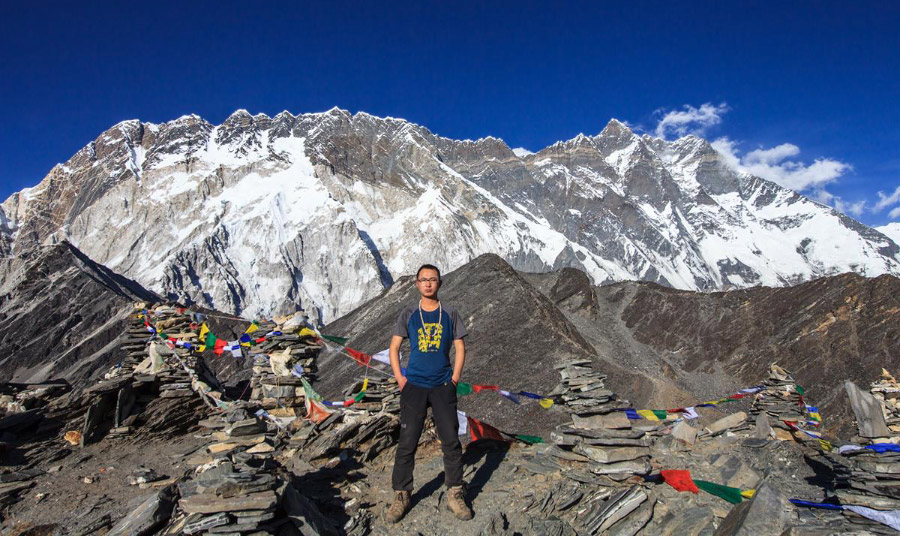
The astronomy and celestial beauties: all the time for everybody
By Valentin Grigore

The International Year of Astronomy 2009 was the most important global celebration of astronomy in the human history.
After this incredible event when people from all over the world experienced together the beauties of the sky, Astronomers Without Borders continue to encourage people to share the same sky through Global Astronomy Month, a model about how we can promote astronomy and education through astronomy whole the year and for all people.
The Romanian Society for Meteors and Astronomy (SARM) was founded in 1993 to fill the gap in popular astronomy created in Romania by a former totalitarian regime.
The concept of SARM, astronomy-culture-art-education-society, has been materialized through events organized during whole the year:
- astronomical camps, events and activities of popularization of astronomy in schools, museums, universities, theatres, cultural centers, public libraries,
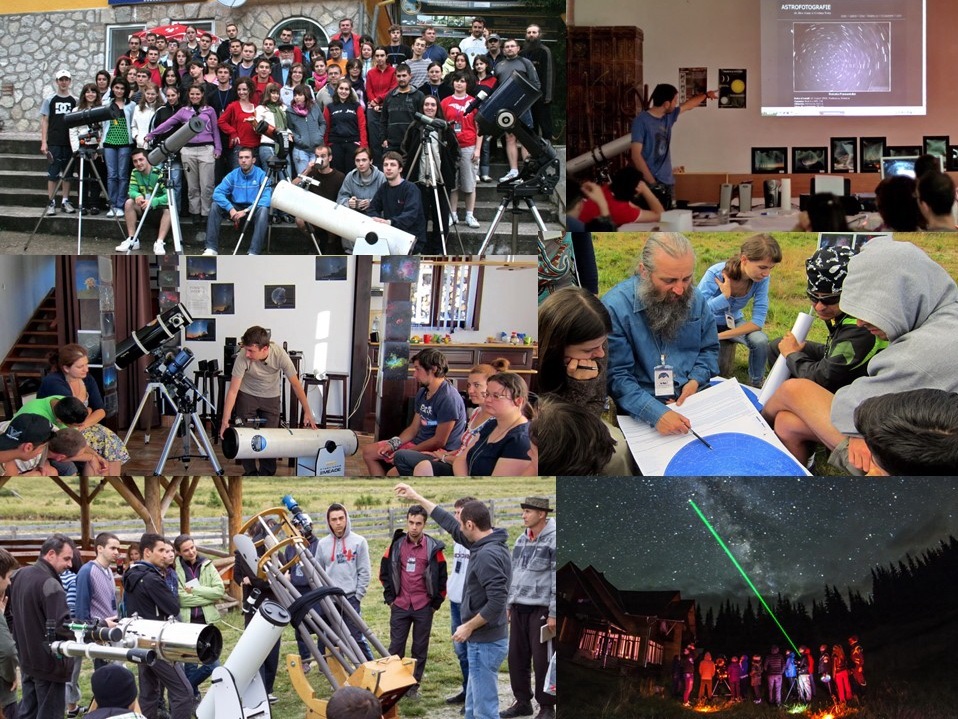
houses for people with disabilities and even prisons, culminating with the annual Perseid national camp (including a summer astronomical school), the national contest of astrophotography, Noi si Cerul (Us and the Sky) TV show, national galas of astronomy and cosmopoetry festivals;

- national and international expeditions for the observation of more sky phenomena and visiting the largest telescopes in the world;
- participations at international conferences and projects of observational astronomy and astrophotography.

Later, SARM gladly became part of Astronomers Without Borders, the new international house of the celebration of astronomy, whose astrohumanist principles for spreading astronomy all over the world are quite impressive.
That’s why the Global Astronomy Month has become the highest invitation for people to be both earthly and cosmic.
That’s why every year SARM tries to be a good contributor for this event, following its traditional creeds, like these:
"Come with us and admire
The splendors of the starry sky.
Look at the bright stars and discover
He Who Created The Light.”
-Valentin Grigore-
"In the House of the Universe
Say: It’s mine!
But talking to stars
You must shine.”
-Andrei Dorian Gheorghe-
 Valentin Grigore is the founder and President of the Romanian Society for Meteors and Astronomy (SARM), the national society of astronomy in Romania. He started his activity in astronomy in 1982 (14 years old) as autodidact. He is the founder of the Romanian meteor school and of the annual national astronomical camp and summer astronomical school "Perseide" (first edition in 1993), the most important astronomical event in Romania. Also, in 2000 he founded the biennial Astrophotography National Contest and International Exhibition. In 1992 he became member of the International Meteor Organization (IMO). Currently, he is the National Coordinator in Romania of the Astronomers Without Borders, member in the Committee of Initiative of EURONEAR project (European Near Earth Asteroids Research) and Board Member of One Star at a Time: Reclaim the Starry Night Sky. In the last 25 years, Valentin leaded hundreds of educational and observational astronomical projects in Romania and abroad. In 2000 and 2011 he led the organization of the International Meteor Conference in Pucioasa and Sibiu (Romania). Since 2008 he is the producer of "Noi si Cerul" (Us and the Sky) astronomical TV show in Romania.
Valentin Grigore is the founder and President of the Romanian Society for Meteors and Astronomy (SARM), the national society of astronomy in Romania. He started his activity in astronomy in 1982 (14 years old) as autodidact. He is the founder of the Romanian meteor school and of the annual national astronomical camp and summer astronomical school "Perseide" (first edition in 1993), the most important astronomical event in Romania. Also, in 2000 he founded the biennial Astrophotography National Contest and International Exhibition. In 1992 he became member of the International Meteor Organization (IMO). Currently, he is the National Coordinator in Romania of the Astronomers Without Borders, member in the Committee of Initiative of EURONEAR project (European Near Earth Asteroids Research) and Board Member of One Star at a Time: Reclaim the Starry Night Sky. In the last 25 years, Valentin leaded hundreds of educational and observational astronomical projects in Romania and abroad. In 2000 and 2011 he led the organization of the International Meteor Conference in Pucioasa and Sibiu (Romania). Since 2008 he is the producer of "Noi si Cerul" (Us and the Sky) astronomical TV show in Romania.
He is an active militant for the protection of the dark-sky.
Valentin's State of Sky
Valentin on Facebook
Closer to the Stars, since the year 2000
By Ricardo Cardoso Reis (Planetário do Porto & Instituto de Astrofísica e Ciências do Espaço)
The Planetário do Porto - Centro Ciência Viva (Porto Planetarium - Living Science Center) opened to the public in November 1998, but its history actually started years before.
It is a rare case of a science center managed by a research center. And when it was founded in 1989, the Centro de Astrofísica da Universidade do Porto (and the Instituto de Astrofísica e Ciências do Espaço, since CAUP’s merger with its counterpart in the University of Lisbon) has in its statutory objectives the support and promotion of Astronomy, through research, education, activities for schools and science outreach. That’s why, as early as 1990, CAUP started a portable planetarium program, which still travels to schools.
Leaping forward to 1997, CAUP took an active role in the very first “Astronomy in the Summer” national activity, organized by Ciência Viva, the Portuguese national agency for scientific and technological culture.
So, public observation with telescopes was something we already had experience with when the planetarium opened. That’s why about a year later, in January of the year 2000, we decided to create “Mais Perto das Estrelas” (Closer to the Stars), a walk in, free or charge, monthly telescope observation night.
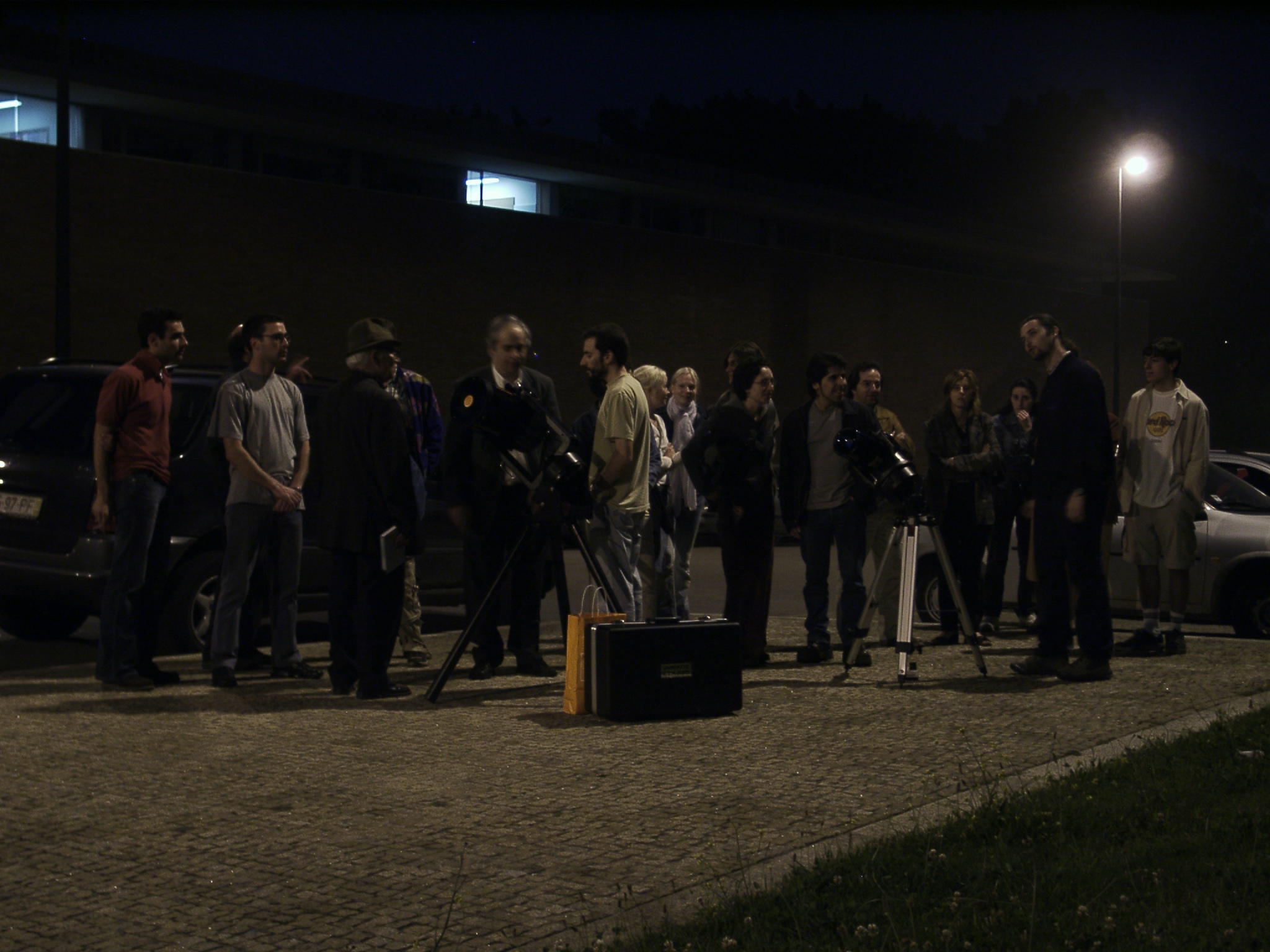 The first incarnation of Closer to the Stars, outside the planetarium building, in 2002.
The first incarnation of Closer to the Stars, outside the planetarium building, in 2002.
Initially, it was just observation. Every second Thursday, starting at 21h00, we’d set up our telescopes outside the planetarium, and stayed for as long as we had visitors, which sometimes meant one lone straggler that stayed past midnight. Since Friday is a work day, and schools arrive early in the morning for planetarium shows, eventually we had to set 23h00 as the time limit.
Bad weather would sometimes force us to cancel the activity, but despite that (and our many warnings that the activity would not happen with bad weather), some people would still show up, sometimes after driving for dozens of km, just to return home disappointed.
Because of those cases, we started to use the wonderful resource at hand – the Porto Planetarium dome. Every “Closer to the Stars” now starts with a mini presentation of about 10 minutes, showing the sky that night. With bad weather, we extend the presentation up to half an hour.
 Constellations inside the Porto Planetarium dome, during the mini sky presentation.
Constellations inside the Porto Planetarium dome, during the mini sky presentation.
After the demonstration, if the weather permits, we move outside to our previously set up telescopes, and observe for up to 1,5 hours.
During that time, we observe whatever astronomical objects are above the planetarium walls, which block the sky up to about 35 degrees over the horizon. It seems a lot of sky to lose, but atmospheric turbulence close to the horizon and light pollution in Porto render that area useless for observation anyway, so it’s not a big loss.
Actually, light pollution, together with fog (Porto is a city with river and ocean, both of them very near the planetarium) are our worse enemies. Even bright deep sky objects, visible with the naked eye in a dark sky, can only be seen with a telescope here.
But Porto is not a city with an extremely high level of light pollution, so if there is no fog, we are able to show the craters of the Moon, the rings of Saturn, the phases of Venus and the moons and stripes of Jupiter. In a good night, we can also see the core of the Andromeda galaxy, the Ring Nebula, Hercules Star Cluster or Orion’s Nebula.
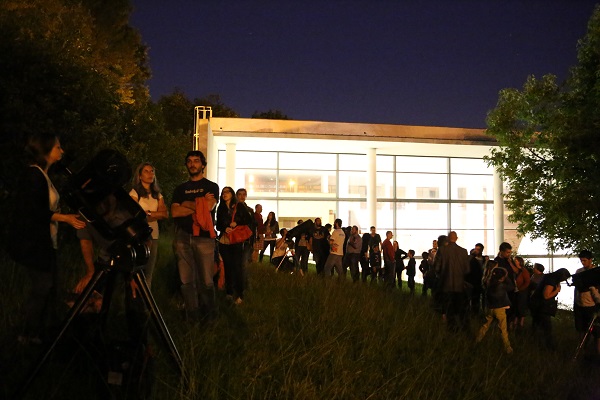 Current Closer to the Stars format, at the inside garden of the planetarium.
Current Closer to the Stars format, at the inside garden of the planetarium.
Usually, “Closer to the Stars” is a two person crew. One presents the sky in the planetarium, while the other sets up the telescope(s). When we move outside, one mans the telescope and the other talks to visitors (answering general astronomy questions, talking about research at IA or showing, in the real sky, some of the constellations shown inside the dome). When the crowd is really big, each takes one telescope and talks to the visitors.
The turnout is very seasonal. We have few people during the winter months, and go up to a couple of hundred during the summer. Unusually large crowds gather during rare astronomical events, like eclipses or even “super” Full Moons.
 Huge rows of people waiting to see the "Super" Full Moon of 14th of November 2016
Huge rows of people waiting to see the "Super" Full Moon of 14th of November 2016
Many times we are asked “Why not take these observations to darker places?”
We did try it, but the turnout was disappointing. Some exceptions were the few times where the observations were included in larger programs, like Dark Sky Party Alqueva or Astronomy in the summer.
 Photo of the Moon taken through our telescopes, during the Closer to the Stars edition of 8th of May 2003. |
So, like many sidewalk astronomers around the world would tell you, we have to weigh sky quality versus turnout, and if you want to reach people, you often have to sacrifice the latter for the former. And for most people, who never looked through a telescope, just seeing the craters of the Moon or the rings of Saturn is enough to leave in awe. |
That’s why we keep doing it, every month, without interruption, since the year 2000.
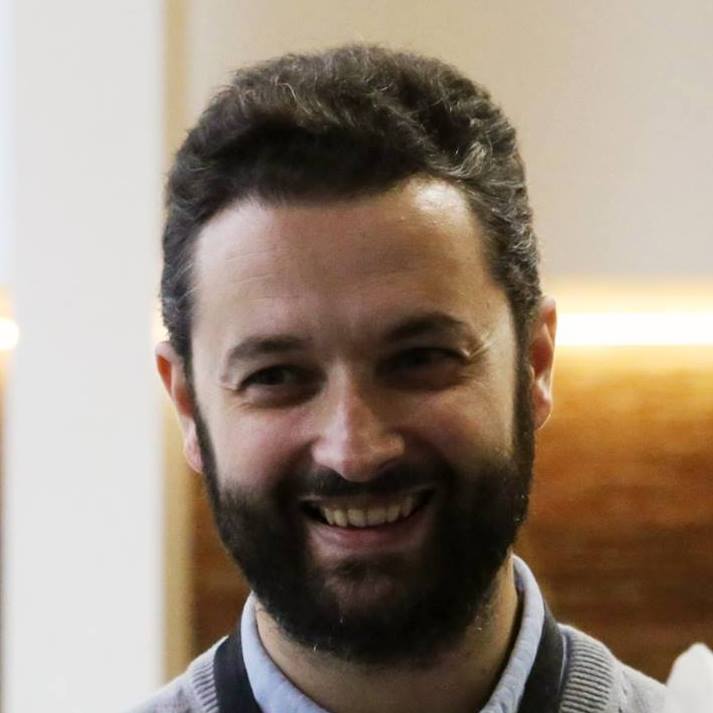 Ricardo Cardoso Reis works as science outreach officer at Instituto de Astrofísica e Ciências do Espaço (IA) and as planetarium producer/presenter at Planetário do Porto – Centro Ciência Viva, in Portugal. Between 2010 and 2012 he was solar activities coordinator for Global Astronomy Month. During the International Year of Astronomy 2009 (IYA2009) he was a member of the International task group and Portuguese co-coordinator for 100 Hours of Astronomy (and co-coordinator of “Sun Day” activity) and Galilean Nights; and the International coordinator of Dawn of IYA2009, the first global event of IYA2009.
Ricardo Cardoso Reis works as science outreach officer at Instituto de Astrofísica e Ciências do Espaço (IA) and as planetarium producer/presenter at Planetário do Porto – Centro Ciência Viva, in Portugal. Between 2010 and 2012 he was solar activities coordinator for Global Astronomy Month. During the International Year of Astronomy 2009 (IYA2009) he was a member of the International task group and Portuguese co-coordinator for 100 Hours of Astronomy (and co-coordinator of “Sun Day” activity) and Galilean Nights; and the International coordinator of Dawn of IYA2009, the first global event of IYA2009.
Final Thoughts, Final Borders!
By Johannes Stübler
We all are sitting in the same spaceship called Earth. Fragile and vulnerable, covered by a thin atmosphere which protects us from space.
If mankind will survive we have to burst all limits and have to leave sometimes our spaceship Earth and we have to learn to deal with the conditions of deep space. Personally I belive that life is an universal phenomenon. The myriad of suns, stars and, as we know today, planets don't make me belive we are the one and only in our universe. Even we are really unique in our universe the more we have the damned obligation to put ourself out for keeping this life going on. All our strength, our knowledge and creativity should be focused on this goal. We all know that life on Earth has an expiration date bound to the life circle of our sun. Long before the hydrogen reserves are over mankind must have done the transfer to space and has to overcome the last frontiers. Beside this last final border we have limited resources and we have to open up new resources which are surley outside of our planet. We must explore our neighbourhood, our solarsystem and later the deep space beyond.
We can do this, but only together. Already today we should work on this from generation to generation we have to pool our forces to reach tis goal, instead of daily redrawing borders and to battle each other. “One People, One Sky“ can be a survival strategy for the future. So the idea of Astronomers Without Borders and “One People, One Sky“ is not only a slogan – it's much more a mission, it can be a kind of philosophy, and a timeless survival strategy for our mankind - worth to be lived – today and now. It pays to encourage and enspire young people every time and everywhere. They are the ones who hold our fortune and the future of our mankind in their hands. GAM is a good chance to do this! A good idea needs no missionary zeal but only people who will understand the mission "One People, One Sky“ and who are willing to break down borders in their daily life. The possible success can come by itself :-)
 Joe Stübler Living in Linz/AUSTRIA (called "Keplertown- Linz", because the famous astronomer Johannes Kepler was living and working in Linz during 1612-1626). Being an amateur astronomer for over 35 years, with extreme desire to network with amateur astronomers and even professionals all over the world, I am totally dedicated to the idea and mission of Astronomers Without Borders and trying to live this idea and mission in my daily astronomical life and work.
Joe Stübler Living in Linz/AUSTRIA (called "Keplertown- Linz", because the famous astronomer Johannes Kepler was living and working in Linz during 1612-1626). Being an amateur astronomer for over 35 years, with extreme desire to network with amateur astronomers and even professionals all over the world, I am totally dedicated to the idea and mission of Astronomers Without Borders and trying to live this idea and mission in my daily astronomical life and work.
Daily Menu
By Grom D. Matthies
Around volcanic vents deep down on oceans floor, tiniest creatures thrive on what the inners of Earth provide. They feed, not unlike a washing machine, on energy and some chemicals that would cook or corrode any decent surface creature instantly. Those tiny fellows, however, tend not to age a lot as they are prey to some other, slightly bigger critters who love to chew on snacks with a strong taste of sulfur and whatnot. These critters are in turn the staple food for the digestive apparatus of even bigger ones. We humans call this sequence a food chain. This chain works quite well albeit existing in eternal darkness separated from all the rest of what we call life.
Permanent feeding frenzy
In less deeper waters and on dry land things are no different. We know that well. Eat or be eaten, an expression which never seems to loose validity. Weren’t it for our ingenious way of perpetuating and applying knowledge, humans barely would make a rank amongst the top ten predators of this food chain. Bowing to the circumstances of life, we tend to shrug shoulders – “that’s nature” – and keep on avoiding lions, sharks and tax officials etc. whilst holocausting on what the landscape provides in edible flora and fauna.
Upping the scale, even the inanimate, the lifeless, partakes in a weird kind of food chain on its own. Rocks, asteroids and comets, the most numerous objects in any stellar system are constantly gobbled up by bigger ones, like planets and moons.
Stars are no predatory exception. Though they do not need the nutritional input of their surroundings, their gravity has the same fatal outcome to any object suffering orbital motion disorder as do have the sharp claws and teeth of a cat on a distracted mouse venturing too close.
Stars are pretty much self-contained. They are born with all the food they need. However they do not necessarily escape occasional mishaps. More than half of all stars are part of binary or multiple star systems. As our telescopes confirm, quite often a bigger and much more massive star tends to cannibalize on its smaller less massive brethren. Sometimes it’s exactly the other way round –many novae and a certain type of supernovae are the visual outcome, as astronomers figured out.
Universal meal
The eat or be eaten campaign permeates all, from the tiniest existence to the biggest objects there are – galaxies. Proven, verified and filed away as fact, our galaxy already swallowed a bunch of smaller satellite galaxies. Most of those gigantic elliptical galaxies out there, as studies and simulations turn to point out, are the obese results of big spiral galaxies, like ours, eating another big galaxy.
This universe is apparently a feeding feast up to its most distant, though admittedly non-existing corners.
Laws of thermodynamics considered – all the energy that makes up our universe, plus all the energy digested, by division with c-squared, into matter had to come from somewhere. Meaning, most likely, some ‘otherverse’ (one or more of the possible multiverses, just not this one) is probably missing a huge chunk of energy or got swallowed whole to feed and fill the space that makes up our dimension. What we call the beginning of it all, the Big Bang, would have been a soundless Big Snack followed by a silent Big Burp (the expansion)– a snack on something that fed it all at once and for good.
Hands-on stars
All the above is obviously not a new cosmic theory. It is rather an odd thought experiment, an attempt to grasp a puzzle by taking an unexpected or unlikely approach. Einstein certainly did so. He overturned the one man point of view physics which fully explains (or rather not) the universe. Now we know it effectively takes two to tango – or in this case, two observation points and their motion relative to each other. That point of view issue is only a starter, culinary pun intended. All the mind bending space-time issues he and others figured out are part of the main course.
Since mankind discovered that our existence (all normal matter and energy) is just a 4% marginal minority inside a universe we can’t even see or feel, things got much more difficult. Depressing thought s apart (who likes to be a member of a tiny minority group), it is definitely relevant to solve the mystery of what the universe actually is and what it is made of or for.
Astronomers, astrophysicists, cosmologists and alike professions struggle. Maybe and hopefully the so much needed ideas must come from a totally different branch or knowledge. Probably there won’t ever be astro-gastronomers to study the cosmos as the above thought experiment would suggest. But as where are now the much sought astrogeologists, astrobiologist, astrochemists and so forth, to explain the workings in our and neighboring stellar systems, an equally different mindset is needed to make the next step in understanding the cosmos.
This more recent broadening of the interdisciplinary approach to science is, at least in education, by far more productive than the specialization in a single discipline. It is also more fun – the gastronomic approach in all its extent (not this downsized form here) certainly was.
So, all you amazing minds out there – give it a go and set your brains onto the stars. Leave the heavy math for later or others. What is needed is a new or at least different point of view. Whatever it will be, it sure will be a wondrous journey for the collective minds we are part of.
 Until recently Grom D. Matthies developed and test applied inquiry oriented science education resources and software for schools and public outreach. Currently he is looking for new, exciting feeding grounds.
Until recently Grom D. Matthies developed and test applied inquiry oriented science education resources and software for schools and public outreach. Currently he is looking for new, exciting feeding grounds.





